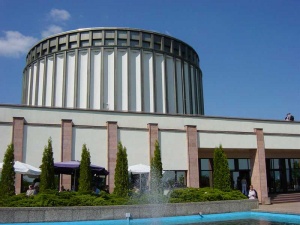Frühbürgerliche Revolution in Deutschland (Painting)
Frühbürgerliche Revolution in Deutschland by the East German artist Werner Tübke (1929-2004) is a painting known in English as Early Bourgeois Revolution in Germany or as Peasant’s War Panorama. The painting, 14 by 123 metres (46 by 403.5 feet), was the world's largest oil painting in 2012. It depicts scenes from the Great German Peasant War (Große Deutsche Bauernkrieg) centered on their leader, the revolutionary Anabaptist Thomas Müntzer (1488/89-1525). The artistic style is Magical Realism.
The painting is housed in its own Panorama Museum in Bad Frankenhausen, Germany, near the site of the disastrous 1525 Battle of Frankenhausen. The museum, a popular tourist attraction in the spa town, opened 14 September 1989, just eight weeks before the fall of the Berlin Wall and the end of the Deutsche Demokratische Republik (DDR, East Germany)
The Communist political leaders of the Deutsche Demokratische Republik felt a strong historical connection with the German peasants who heroically revolted in 1524-1525 against high church officials and oppressive nobility. The East German Communist Party leaders held Müntzer in high esteem for in his "Confession" is found the Latin phrase "omnia sunt communia" which is understood to mean: "Everything should belong to everyone." This became the basis for the belief that Müntzer, who preached for the eradication of barriers between different classes and social levels, was the first German revolutionary, and one of the first to lay the ground for socialism in German lands. For 20th century Communists Müntzer’s ideas of social materialism were a forerunner of the bourgeois revolution and their form of communism. However, Communists downplayed the importance of political and religious causes for the peasant’s war. Much of their regard for Müntzer derived from Friedrich Engels’ book: Der deutsche Bauernkrieg (The Peasant War in Germany) (1850).
The panorama painting emerged from the planning for the 450th anniversary celebrations of the Great German Peasant War which were held in East Germany in 1974-1975. The East German Communist Party (Sozialistische Einheitspartei Deutschlands) commissioned Professor Werner Tübke, rector of Leipzig Academy of Visual Arts, to create the monumental painting.
Frühbürgerliche Revolution in Deutschland took 12 years to complete. It has a very complex composition and depicts more than 3,000 individuals drawn from many spheres of the Renaissance and Reformation. In the early 21st century the paining is interpreted to represent an allegory of the doomed German Democratic Republic. This view understands Thomas Müntzer as one who knows his vision of a better future for the peasant rural population had failed, much like the vision of the East German leadership of a socialist state had failed. An alternative interpretation says the painting portrays the general transience of all existence--a view emphasized by the painting's round character. This interpretation is not limited failed peasant uprising under Thomas Müntzer--the historical parallel to the failure of the DDR--but to all social processes in this and other times.
The painting's content is filled with allusions to classic European art, to Renaissance images and contains powerful elements of satire. The center of the panorama and the section most reproduced is the Battle of Frankenhausen itself, with Thomas Müntzer in the center. In contrast to almost all other battle panoramas, Thomas Müntzer is depicted not as a triumphant leader but rather as one in anguish and resigned to defeat, standing alone among his troops with his Bundschuh (tied shoes) pendent on the ground. Müntzer was captured and beheaded a few days after the battle.
Bibliography
Gillen, Eckhart. "One can and should present as artistic vision ... of the end of the world”: Werner Tübke’s Apocalyptic Panorama in Bad Frankenhausen and the end of the German Democratic Republic." Getty Research Journal 3 (2011):99-116.
Wikipedia contributers. "Bauernkriegspanorama." Wikipedia. 27 July 2012. http://de.wikipedia.org/w/index.php?title=Bauernkriegspanorama&oldid=104075805
Additional Information
Address: Panoramamuseum, Am Schlachtberg 9, 06567 Bad Frankenhausen, Germany
Phone: 49 (0) 34671 619 0
Website: http://www.panorama-museum.de/
| Author(s) | Victor Wiebe |
|---|---|
| Date Published | July 2012 |
Cite This Article
MLA style
Wiebe, Victor. "Frühbürgerliche Revolution in Deutschland (Painting)." Global Anabaptist Mennonite Encyclopedia Online. July 2012. Web. 22 Nov 2024. https://gameo.org/index.php?title=Fr%C3%BChb%C3%BCrgerliche_Revolution_in_Deutschland_(Painting)&oldid=64279.
APA style
Wiebe, Victor. (July 2012). Frühbürgerliche Revolution in Deutschland (Painting). Global Anabaptist Mennonite Encyclopedia Online. Retrieved 22 November 2024, from https://gameo.org/index.php?title=Fr%C3%BChb%C3%BCrgerliche_Revolution_in_Deutschland_(Painting)&oldid=64279.
©1996-2024 by the Global Anabaptist Mennonite Encyclopedia Online. All rights reserved.
